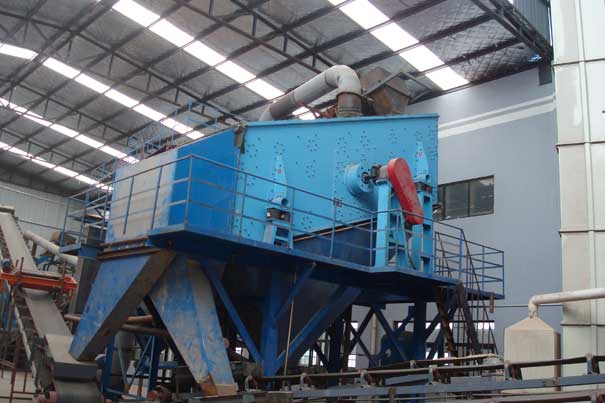The vibrating screen is common equipment in the crushing process. The vibrating screen is operated by the reciprocating vibration generated by the vibrator. The upper rotating weight of the vibrator causes the screen surface to produce plane whirling vibration, while the lower rotating weight causes the screen surface to produce cone-shaped rotary vibration. The combined effect of the vibrator causes the screen surface to produce multi-rotating vibration. Its vibration trajectory is a complicated spatial curve. The curve is projected as a circle on the horizontal plane, and projected as an ellipse on the vertical plane. The amplitude can be changed by adjusting the excitation force of the upper and lower rotating weights. Adjusting the spatial phase angle of the upper and lower weights can change the curve shape of the screen surface movement trajectory and change the movement trajectory of the material on the screen surface.
Vibrating screens are mainly used for grading broken rocks, ore or sand in mining, hydropower, and highway construction to obtain products of different sizes. The screen is an important part of the vibrating screen. When the vibrating screen is in use, materials often block the screen holes and cause the screen to be damaged, especially when the screen mesh is small, this phenomenon is more obvious. Due to the variety of material particle shapes, the reasons for blocking holes are also various.

There are mainly the following 5 reasons for blocking holes in the screen:
- Contain a large number of critical material particles close to the separation point. That is, the particle size of the crushed stone is critical to the mesh size of the screen. During the sieving process of the stone, such particles are stuck in the mesh and cannot pass through the sieve smoothly, which called critical hole is blocking.
- There are many flake particles. Due to the reasons of crushing or the stone itself, there are many flake materials in the stone material, and the flake material itself cannot be smoothly passed through the sieving material. The irregular shape of the material and the sharp angles make it impossible to pass smoothly. At the same time, the flake materials are woven into a net shape, which prevents other materials from passing through the screen and causes blockage.
- The diameter of the steel wire used to make the screen is too thick. The shape of the mesh screen generally uses square holes, and small meshes use anti-blocking holes. If the holes are really blocked, rectangular holes can also be used without affecting the particle size of the stone. However, considering the life cycle, the mesh direction must be paid attention to, otherwise it will affect the life cycle of the screen.
- There are many materials with multiple contact points on the sieve.
- The material has high viscosity and high water content. The screened material has high water content and contains viscous substances such as mud and sand. Because there is a lot of mud in the stone, or when the stone requires water washing, the fine-grained stone will stick to each other into agglomerates due to the intervention of water on the one hand, and the soil will stick to the screen surface on the other hand, making it difficult to screen the material and causing the hole to be blocked.
For a long time, the rapid wear rate of the screen has caused huge troubles to many stone manufacturers. If this problem is not solved, frequent replacement and shutdown will be required, which directly affects the economic benefits of the enterprise.

